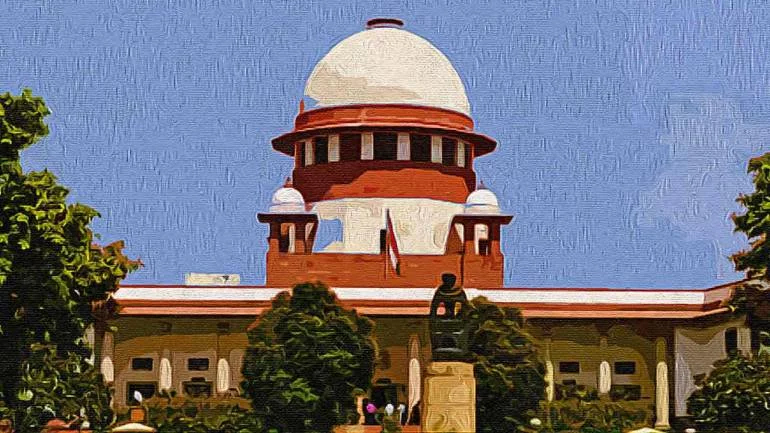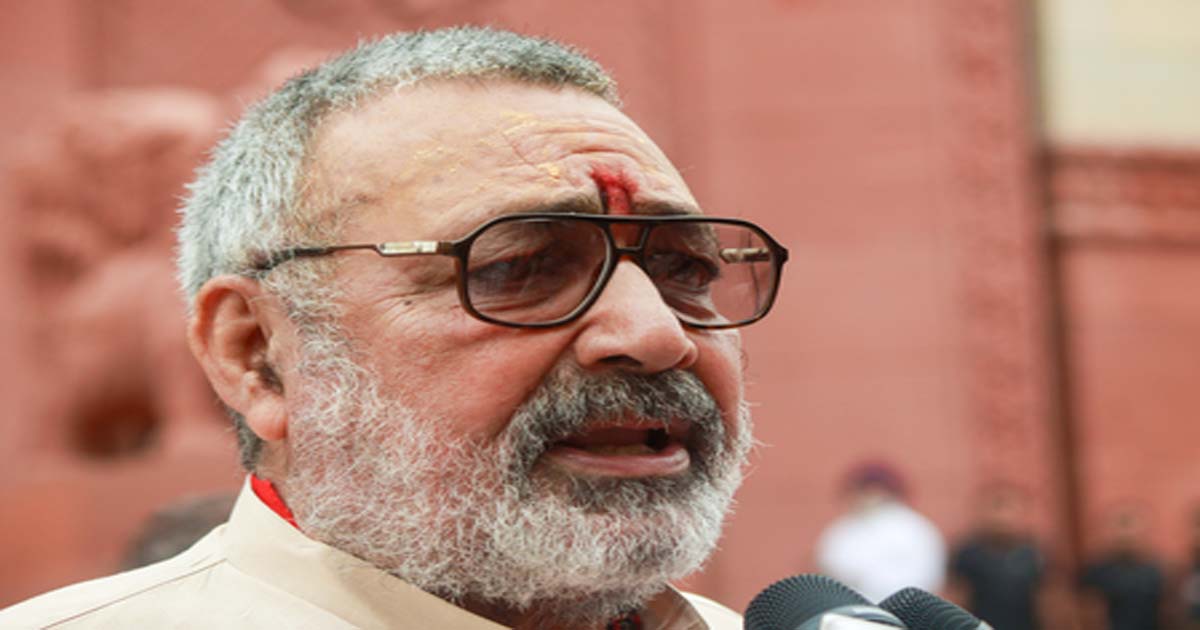National News
The Anti-Corruption Branch of the Maharashtra Police has started an investigation into the forgery complaint against the retired justice of the Supreme Court and the Bombay High Court.

New Delhi:- Anti-Corruption Department of Maharashtra Police had started investigation against Retired Supreme Court Judges & other Co-accused.
The investigation is started on the complaint given by Shri. Rashid Khan Pathan, Chairman of ‘Supreme Court & High Court Litigants Association of India’ (SC & HCLAI).
The Grievance of the Complainant
The Complainant and Adv. Vijay Kurle had filed a complaint on 19.03.2019 against Justice R.F. Nariman & Justice Vineet Saran for passing unlawful orders to serve their ulterior purposes and to help another accused Judge S. J. Kathawalla.
In order to save accused Judges from charges, one conspiracy was hatched by co-conspirator Adv. Milind Sathye of Bombay Bar Association & Kaiwan Kalyaniwlala of Bombay Incorporated Law Society and in furtherance of the said conspiracy, they sent a Joint letter dated 23.03.2019 to the Chief Justice of India.Then Chief Justice of Indian Shri Ranjan Gogoi found nothing actionable in the said letter dated 23.03.2019 by Bombay Bar Association & Bombay Incorporated Law Society and therefore the Chief Justice of India passed an order to close the said complaint.
But accused Milind Sathe & others hatched a criminal conspiracy with accused Judges Rohinton Nariman and created a forged record of Supreme Court to the effect that the then Chief Justice of India had forwarded the said complaint to the Bench of Justice R.F. Nariman.
On the basis of the said forged record, the accused Judges R.F. Nariman themselves took the cognizance of the contempt against complainant where the said Judges were accused.
When trial for contempt started, the Respondents produced all the evidences including records of the Chief Justice of India office and Supreme Court Registry.
These records were found to be destroyed/stolen by the accused Judges which is an offence under Section 409 of the IPC and accused Judges can be punished for life imprisonment. The Accused Judges pronounced the order of Conviction and sentence against Complainant on 27.04.2020.
The said conviction & sentence is challenged by the way of writ petition filed by Rashid Khan Pathan & Others. The said judgement of conviction is partly overruled by the larger bench of the Supreme Court in Re: Prashant Bhushan’s case 14 August 2020. It is specifically observed by the larger bench that the rule laid down in P.N. Duda’s case is binding on the Supreme Court and only Chief Justice can take the cognizance of Suo moto contempt on the letter sent by the parties. If the said rule is not followed, then conviction of contempt stands vitiated. Similar law is laid down in Bal Thackeray vs. Pimplekhute (2005) 1 SCC 254 & Campaign for Judicial Accountability and Reforms vs. Union of India, (2018) 1 SCC 196.
The Supreme Court stayed said sentence and the petitions are tagged with the writ petition filed by Adv. Prashant Bhushan W.P. (C) No. 1037 of 2020. Other writ petitions are Rashid Khan Pathan vs. Union of India bearing No. WP (C) No. 1377 of 2020, Adv. Vijay Kurle vs. Supreme Court of India through Secretary General & Others bearing No. WP (Cri) No. 243 of 2020 & Adv. Nilesh Ojha vs. Supreme Court of India through Secretary General & Others bearing No. WP (Cri) No. 244 of 2020.
In the meantime, two agents sent by Retd. Justice Deepak Gupta, Justice Rohinton Nariman approached Complainant at his residence and gave offers of Rs. 400 crores to settle the entire matter. There were another talks exposing the racket of Agents of corrupt Supreme Court Judges. All proofs are available with the Complainant.
The Complainant forthwith made complaint to the CBI and other authorities.
The Anti-Corruption Department of Maharashtra police on the directions given by the higher authorities started investigation.
The Complainant was summoned to produce the concerned proofs. The Complainant gave the proofs and the police recorded his statement.
The offence disclosed against the Accused retired Judges are cognizable, non-bailable and punishable with life imprisonment and an offer of cash amount of Rs. 400 crores. The forgery and destroying of the Supreme Court records is ex-facie proved from the written communication given by the Chief Justice of India.
Therefore, various Indian Bar Association & Supreme Court lawyers Association had demanded immediate arrest of Accused Judges and co-conspirators Adv. Milind Sathye, Kaiwan Kalyaniwalla & ors.
National News
‘Jaha jati hai jeetkar hi aati hai’: PM Modi hails Richa Ghosh’s winning streak, calls Team India’s victory a result of hard work

New Delhi, Nov 6: Prime Minister Narendra Modi, while engaging with the World Cup-winning Indian women’s cricket team, praised the individual efforts of the players in achieving the collective goal of claiming the coveted trophy. One such player was wicketkeeper-batter Richa Ghosh, who also holds the U19 World Cup trophy in her cabinet alongside the WPL title.
During the interaction at his official residence at Lok Kalyan Marg, PM Modi highlighted Richa’s achievements and said, “Richa, you win every game you play, don’t you? Richa gets a chance everywhere.”
To this, Richa, with a shy smile, replied, “I don’t know, sir. But yes, when we were under-19s, seniors, and in the WPL, we used to win trophies.”
Richa played the semifinal against Australia and the final with a hairline fracture in her left-hand middle finger. She had originally sustained the injury while keeping against New Zealand in the group stage and sat out of the washed-out fixture against Bangladesh.
“When we used to bat, we used to hit sixes. I think Harry Di (Harmanpreet), Smriti (Mandhana), and others trusted us. The whole team trusted us. If there’s a situation where the balls are fewer but you need more runs, they trust us — that’s why I got the confidence that ‘you can do it’,” Richa added.
Team India had a topsy-turvy campaign, starting with two wins before losing three consecutive matches. But they came back strong, defeating New Zealand and Bangladesh in their final two group games before beating seven-time champions Australia in the semifinal.
Speaking about the team bonding during the tense phase of the tournament, spinner Radha Yadav said, “We lost three games. But the best part was that we were together in defeat. We were backing each other and talking to each other. So it was genuinely pure. That’s why God gave us this trophy.”
To this, PM Modi replied, “No, no, you’ve earned it with your hard work,” and then asked the team how they had prepared for the mega event.
Radha said, “Sir, like you said, we’ve been playing cricket very well for a long time. We were preparing for every situation — fitness-wise, fielding-wise, and skill-wise. We had been working hard for that for a long time. And like I said, if everyone stays together, it becomes easy. If someone is alone, it’s very difficult for him or her to work.”
The PM then asked Radha, “I’ve heard that in the beginning, you spent your prize money to help your father. And your father kept encouraging you?”
“Yes, all the time. I mean, it was not that easy in our family at that time…” Radha responded.
Speaking to the PM about India’s historic triumph, all-rounder Sneh Rana said, “Sir, it’s a lot of hard work. And our bowling coach, Avishkar, we were talking to him a lot — about how to tackle a batter. So, we try to replicate all the strategies that are made with the captain, vice-captain, and head coach. And thankfully, it worked.”
“There are a lot of matches where we can’t do it. But still, we motivate ourselves to do better next time,” she added.
National News
India has Constitution, not Sharia Law: Giriraj Singh on Burka issue

New Delhi, Nov 6: Union Minister Giriraj Singh on Thursday strongly addressed the burka controversy and claims of Sharia law during the first phase of voting in the Bihar Assembly elections, emphasising that India has its own Constitution.
Speaking after casting his vote at polling booth number 43 at Middle School Barahiya Number-2, Singh emphasised that India follows its own Constitution and that religious customs cannot override identification or election procedures.
Singh, who arrived early and was the first voter at his booth, said, “…I showed that the Anganwadi worker was here regarding the burka issue. The Election Commission has made proper arrangements and established rules stating that if someone objects, the person should lift their burka for identification. When people go to make an Aadhaar card, there’s no mention of Sharia law. When they go for a reservation or to the airport, there’s no Sharia law there either. It’s only here that some claim Sharia law applies. This is not Pakistan. This is India. India has its own Constitution, and that is what will be followed.”
The Union Minister also addressed cultural and religious themes, reiterating the importance of temple construction in India. He stated, “If temples are not built here, where will they be built… in Pakistan!”, highlighting his belief that the country’s Sanatan identity must be preserved.
Giriraj Singh expressed confidence in the NDA’s prospects in the Bihar elections, claiming the alliance would repeat or even surpass its 2010 electoral performance.
The first phase of polling for the 2025 Bihar Assembly elections began at 7 a.m. across 18 districts, covering 121 constituencies with over 3.75 crore voters eligible to cast their votes. Polling stations have been fortified with unprecedented security arrangements, including police and paramilitary forces deployed across sensitive and hyper-sensitive booths.
Voters in Singh’s constituency and across the state are reportedly focused on development, education, and employment, while security and electoral fairness remain key priorities. Singh’s early presence at the polling booth, along with his outspoken remarks, underlined the political intensity and cultural debates surrounding this election phase.
Voting for the first phase continues until 6 p.m., while in Naxal-affected constituencies it will conclude at 5 p.m.
Crime
Mumbai Crime: Serial Snatcher Who Targeted Women At D Mart Stores Arrested

A 53-year-old habitual offender was arrested by the MHB Police and identified as Bapi Ratan Bhattacharya. He was accused of stealing women’s purses and valuables from busy supermarkets repeatedly. Bhattacharya, dubbed a ‘serial snatcher’ by the police, was apprehended in Mira Road on Saturday after weeks of investigation.
In a statement given by the cops to Media, Bhattacharya would exploit the chaos of crowded shopping areas, especially popular D Mart outlets, to discreetly lift purses and bags placed in shopping trolleys. Most of his victims were women distracted while shopping. Investigators revealed that Bhattacharya had been involved in more than 10 similar thefts across various supermarket branches in Mumbai and nearby areas.
His latest crime came to light after a Dahisar West resident filed a complaint stating her purse had been stolen while she was shopping with her two-year-old son at D Mart, Kandarpada. The stolen bag contained cash, ATM cards, and important documents. Within minutes, ₹20,000 was withdrawn from her husband’s account using one of the stolen cards.
Following the complaint, police teams led by DCP Sandeep Jadhav (Zone XI), Senior Inspector Harish Gavli, and PSI Nilesh Patil analysed CCTV footage and used technical surveillance to trace Bhattacharya’s movements. The accused was later arrested from Mira Road. During interrogation, he confessed to multiple thefts carried out in a similar fashion across several D Mart branches.
An officer said, “More than ten cases have been registered against Bhattacharya across Mumbai and nearby police stations. Whenever a theft is reported at a supermarket, his name is the first to come up. We have already solved two pending cases after his arrest.”
The accused has been booked under relevant sections of the Bharatiya Nyaya Sanhita (BNS) and Information Technology Act, police said, adding that further investigations are underway to identify his other offences and potential accomplices.
-

 Crime3 years ago
Crime3 years agoClass 10 student jumps to death in Jaipur
-

 Maharashtra1 year ago
Maharashtra1 year agoMumbai Local Train Update: Central Railway’s New Timetable Comes Into Effect; Check Full List Of Revised Timings & Stations
-

 Maharashtra1 year ago
Maharashtra1 year agoMumbai To Go Toll-Free Tonight! Maharashtra Govt Announces Complete Toll Waiver For Light Motor Vehicles At All 5 Entry Points Of City
-

 Maharashtra1 year ago
Maharashtra1 year agoFalse photo of Imtiaz Jaleel’s rally, exposing the fooling conspiracy
-

 National News1 year ago
National News1 year agoMinistry of Railways rolls out Special Drive 4.0 with focus on digitisation, cleanliness, inclusiveness and grievance redressal
-

 Maharashtra12 months ago
Maharashtra12 months agoMaharashtra Elections 2024: Mumbai Metro & BEST Services Extended Till Midnight On Voting Day
-

 National News1 year ago
National News1 year agoJ&K: 4 Jawans Killed, 28 Injured After Bus Carrying BSF Personnel For Poll Duty Falls Into Gorge In Budgam; Terrifying Visuals Surface
-

 Crime1 year ago
Crime1 year agoBaba Siddique Murder: Mumbai Police Unable To Get Lawrence Bishnoi Custody Due To Home Ministry Order, Says Report












